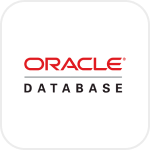
- Overview
- Configuration
Oracle DB
Automate account provisioning with Oracle Database and ADManager Plus
Oracle Database is a powerful and widely used database management system that organizations across industries and sizes have relied on for years to store employee details for HRMS applications. With hands-free account provisioning, maintenance, and deprovisioning made possible through ADManager Plus' integration with Oracle Database, account management is easier than ever for HR managers and IT administrators.
HRMS-driven user life cycle management
Implement HR-driven user life cycle management in AD, Exchange mailboxes, Microsoft 365 accounts and more.based on data input from the HR team.
Eliminate errors during user provisioning
Experience error-free user provisioning by importing CSVs with rule-based intelligent templates
Delegate tasks to technicians
Reduce the workload on IT administrators by delegating user provisioning tasks to non-administrative technicians without the risk of elevating user rights.
Steps to configure Oracle DB settings
- Navigate to the Automation tab and click HCM Integrations.
- Click Oracle DB located under Database.
- In the Oracle DB Settings page, configure the following:
- Server Name: Enter the server name.
- Port Number: Enter the port number to establish the connection.
- Database Name: Enter the name of the database in Oracle.
- Authentication: Enter a User name and Password for authentication
- Click Test Connection and Save to establish a connection and save the settings.
- Click Add Server to configure multiple Oracle databases.
- The Enable Integration button is turned on by default. Toggle it off to disable Oracle DB integration.
Steps to add a new configuration
- Click Add a new configuration.
- In the Description field, enter the details about the new configuration.
- Configure the following details:
- Select Server: Select the desired server from the drop-down menu.
- SID Name: Enter the SID name in Oracle DB.
- Table Name: Enter the name of the table in Oracle DB.
- Automation category: Select the automation type from the drop-down menu.
- Fetch the input for user creation from the Oracle DB table by mapping the DB Column Name to the LDAP Attribute Name.
- Click Save to save the new configuration.
Steps to automate user creation
- Click the Automation tab.
- Select Automation from the left pane.
- Click Create New Automation and configure the following:
- Automation Name: Enter a name for the automation.
- Description: Add a brief note about the automation.
- Automation Category: Choose User Automation from the menu.
- Select Domain: Select the domains and OUs in which the automation should run. Child OUs can be eliminated by selecting Exclude Child OU(s).
- Automation Task/Policy: Select Create Users from the menu.
- Template to be applied: Select the template to be applied for user creation.
- Select Data Source: Click More Options next to Location of CSV. Select Oracle DB from the menu. Enable Ignore current records in DB to ignore the already processed records and consider only the unprocessed records in the Oracle table for user creation.
- Select Config: Select a configuration from the menu. Or click Add New Configuration to add new configuration settings.
- Implement Business Workflow: Select this option if the automation has to be executed through a workflow.
- Execution Time: Configure the automation execution time and repeat the execution using Hourly, Daily, Weekly, Monthly, or Custom options.
- Click Save to save the settings or Save & Run to save the settings and run the automation instantly.
Actions supported:
- Create user accounts
- Modify user attributes
- Modify user accounts using a template
- Reset a password
- Unlock users
- Disable users
- Enable users
- Delete users
- Run custom scripts
- Move users to a different container
- Add users to groups
- Remove users from groups
- Create mailbox
- Disable or delete mailbox
- Move home folder
- Delete home folder
- Revoke Microsoft 365 licenses
- Manage user photos
- Disable Lync accounts
- Auto reply